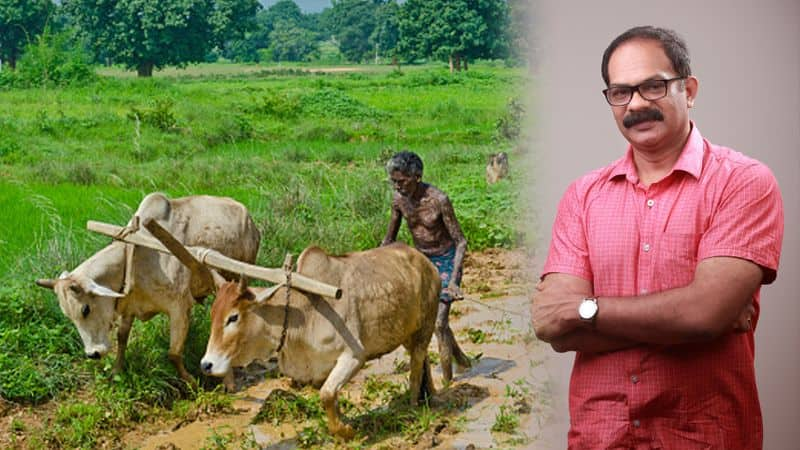The ultimate escape from the vicious cycle of bad debts is withdrawal of the state from both agriculture and banking. Let a free farmer decide his price and conduct farming as a businessman deals with commodities the latter sells. Thereafter, a bank freed of government cannot be forced to grant loans to customers who cannot pay back.
New Delhi: The outstanding amounts of farm loans pending repayment in Madhya Pradesh, Rajasthan and Chhattisgarh are Rs 62,000 crore, Rs 78,000 crore and Rs 7,000 crore respectively. Out of these sums, the banks in the respective states will not get back Rs 35,000 crore, Rs 18,000 crore and Rs 6,100 crore, thanks to the waivers promised by the new Congress governments in these states.
While one may argue that the banks will finally get the money from the governments, the reimbursement will take years to materialise. This will strain the bank's ability to disburse loans further and, worse, it will make them wary of granting loans to farmers in the fear of a repetition of this cycle.
This has been happening in the country for years together, pushing the farmers to non-bank moneylenders who extract a heavy price in the form of high interest rates, making the poor farmer all the more wretched. Under pressure of the popularity of this measure, the BJP governments are forced to adopt the same means to appease the farmers who are not quite sure of the economics of banking assets.
Rajasthan had been, before the announcement of farm loan waiver by the Ashok Gehlot government, burdened with Rs 3 lakh crore of bad debt even as the intended beneficiaries of the waiver, the farmers, have Rs 1 lakh crore debt on them that they can ill-afford to pay back. Out of the 59 lakh farmers that have taken loans in Rajasthan, 26 lakh have availed of loans from cooperatives and rural banks, 24 lakh from nationalised banks and 9 lakh from commercial banks.
That the BJP chooses the direct benefit transfer (DBT) route rather than outright waivers do not address the issue fully. While the DBT ensures there are no transmission losses (money lost to corruption in the state apparatus), the money reimbursed to the banks is after all the money of taxpayers who did not take the loan in the first place.
A sample from Rajasthan will be a classic example of the injustice heaped on the middle class and poor non-farmers (while the poor do not pay income tax, they do pay expenditure tax while purchasing essentials from the market). The former chief minister of the state, Vasundhara Raje, had waived off Rs 50,000 per farmer, to fund which she had to take a loan of Rs 5,000 crore from the National Cooperative Development Corporation that runs on essentially the taxpayers' money. The taxpayers of Rajasthan had already enabled her to 'generously' disburse Rs 3,500 crore after which the then state government needed a further loan mentioned above.
Now consider the nationwide scenario. The amount all states need from different central agencies to repay the old farm loans is Rs 90,000 crore. The future is grimmer. Rajasthan alone will need Rs 70,000 crore to fend for Gehlot's largesse. You and I will pay this amount for loans we never took!
Since 2014-15, the amounts waived have risen by 10.6% in Madhya Pradesh. Overall, it has risen by 24% across the country.
Out of all NPAs, bad farm loans constituted 5.1% in March this year.
The southern states are reeling under the pressure of populism, too. In 2016, the Tamil Nadu government of the AIADMK waived off Rs 6,041 crore of loans that the farmers in the state had availed of. The cooperatives of the state will get only Rs 3,169 crore back from the government — that too not before 2021. Karnataka is worse off. Within three months (March-June) of this year, there was a drop of Rs 5,353 crore in pending agricultural loans. Ironically, despite the Rs 12,000 crore cost to the Karnataka exchequer due to the farm loan waiver announced by the Congress-JD(S) government, the farmers of the state are approaching the Centre with the complaint that chief minister HD Kumaraswamy has 'cheated' them, as reported by MyNation earlier.
The only way out of the vicious cycle of borrowing by distressed farmers and non-payment by them, distressing the rest of the population as well, is a steady and gradual withdrawal of the state from agriculture as well as banking. If the farmers are producing a commodity and selling them, they should be treated as businessmen. But they are hardly businessmen because, unlike other traders, they are not free to decide the price of the commodity (foodgrains, vegetables, etc) they sell. A nationwide farmers' market that Prime Minister Narendra Modi had envisaged is still a distant dream. Farmers, therefore, continue to sell their produce to brokers at APMC markets (which have fortunately been slowly receding).
When the farmer is unable to sell his produce in the season he produced it, the state promises to come to his rescue in the form of the minimum support price, which can never recover the entire investment for the farmer. Then he demands more, but the state cannot afford to pay him more from our money. This also establishes that the much-publicised crop insurance has yet to take off. For, "assessments of the PMFBY (Pradhan Mantri Fasal Bima Yojana) face several challenges that make processing and verification of insurance claims error-prone and time-consuming. Payouts do not reach farmers at the right time and in amounts commensurate with their losses," the Mint reported.
Big, foreign retailers had promised to address the issue by cutting short the middlemen's chain, enabling the farmer to sell at higher prices and us to buy at lower prices, but the dogmatic swadeshi lobbies did not allow it. But if the model of Wal-Mart, Tesco, Carrefour, etc is understood and the need for shorter field-to-market chain appreciated, Indian firms (companies like Reliance Fresh, Aditya Birla Retail, Trent, Big Bazaar, Future Group, etc, for example) can adopt the mechanism, too. Brokers will not be unemployed as a result. They can diversify to ancillary activities like sorting, transportation and storage of crops.
Finally, free, private banks cannot be forced to take imprudent banking decision of lending to customers who cannot repay.
Figures from The Times of India, The Economic Times, Hindustan Times
Last Updated Dec 22, 2018, 8:52 PM IST











![Salman Khan sets stage on fire for Anant Ambani, Radhika Merchant pre-wedding festivities [WATCH] ATG](https://static-ai.asianetnews.com/images/01hr1hh8y86gvb4kbqgnyhc0w0/whatsapp-image-2024-03-03-at-12-24-37-pm_100x60xt.jpg)
![Pregnant Deepika Padukone dances with Ranveer Singh at Anant Ambani, Radhika Merchant pre-wedding bash [WATCH] ATG](https://static-ai.asianetnews.com/images/01hr1ffyd3nzqzgm6ba0k87vr8/whatsapp-image-2024-03-03-at-11-45-35-am_100x60xt.jpg)



